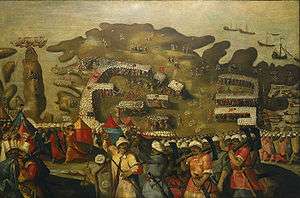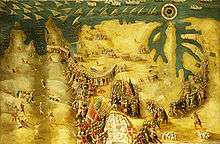Matteo Pérez


Matteo Pérez (1547–1616) was an Italian painter of devotional, historical and maritime subjects during the Mannerist period. He was also known as Matteo da Lecce by virtue of his hometown of Lecce.
He studied under Michelangelo, working on the Sistine Chapel, in the Vatican, painting the Fall of the Angels in the facade facing Michelangelo's Last Judgment. He was a member of the Accademia di San Luca in Rome. He also painted an altarpiece for Sant'Eligio degli Orefici.
He travelled to Naples where he met the artist Pablo Moron, who became his long standing assistant. Perez's most important works can be found in Rome. They include the fresco The Dispute over the Body of Moses (circa 1574) in the Sistine Chapel; frescoes in the Villa d'Este in Tivoli and the Villa Mondragone in Frascati. He also worked in Malta (from 1576), Seville (in the 1580s) and Lima (from 1589), where he died.
The Hall of St Michael and St George, also known as the Throne Room, of the Grandmaster's Palace, Valletta, is decorated with 13 of his frescoes showing the events of the great siege of Malta by the Turks in 1565. He is credited with having introduced mannerism to Malta with his frescoes. These were painted from 1575 to 1581, at the same time as the oil paintings of the same scene, four of which can be found in the Cube Room of the Queen's House, Greenwich, London. Among his other works in Malta there is the Baptism of Christ which was originally the titular painting of the St. John's Co-Cathedral.
He is chiefly known for works he executed in Spain, where he had been induced to migrate in 1583. He completed a monumental fresco, in 1584, in the cathedral of Seville, representing a giant St. Christopher carrying the Infant Saviour on his shoulder. He painted in 1587 the same subject for the church of San Miguel, and he also painted in other public edifices at Seville. After residing some years in Spain, he felt his works were less valued than those of Luis de Vargas, and returned to Rome, where he died. Others tells us that, after having acquired great riches in the West Indies, he died there in poverty.
References
- Bryan, Michael (1886). Robert Edmund Graves, ed. Dictionary of Painters and Engravers, Biographical and Critical (Volume I:, A-K). York St. #4, Covent Garden, London; Original from Fogg Library, Digitized May 18, 2007: George Bell and Sons. p. 18.
- Paintings by Matteo Pérez at the Art UK site
| Wikimedia Commons has media related to Matteo Perez d'Aleccio. |